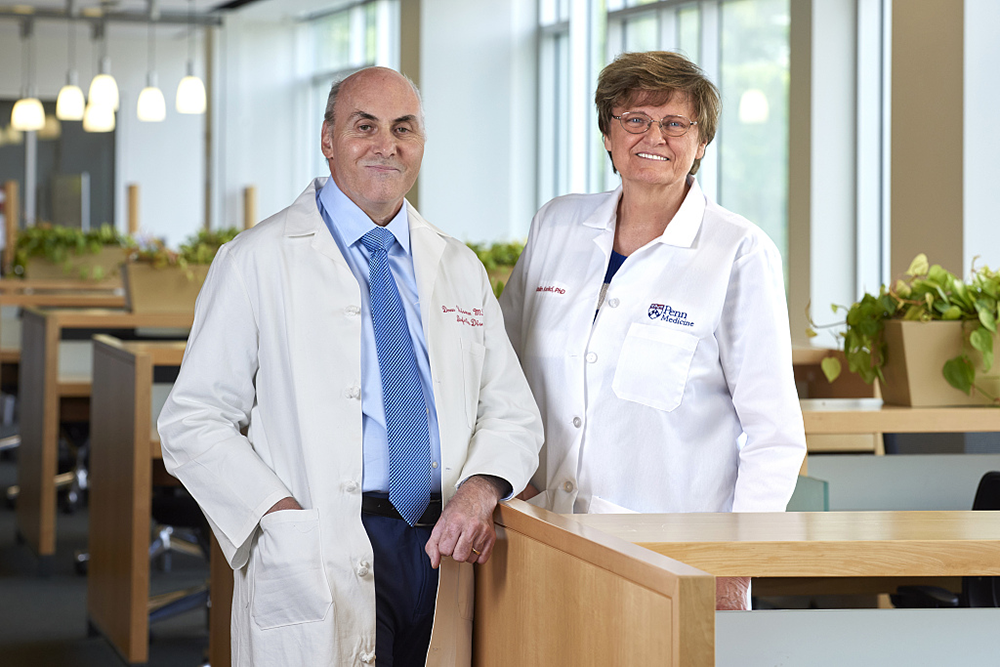
From October 2 to 4, Beijing time, the 2023 Nobel Prize in Physiology or Medicine, Physics, and Chemistry will be announced one after another. Eight scientists received three Nobel Prizes in natural sciences this year. From laying the foundation for the rapid development of mRNA vaccines, to opening the door to the electronic world, to adding color to nanotechnology, their research has taken mankind one step further on the road to exploring the unknown.
Research findings predate COVID-19 pandemic by 15 years

On September 29, 2020 local time, in Philadelphia, the United States, Hungarian scientist Katalin Karikó (right) and American scientist Drew Weissman (left) took a group photo at the University of Pennsylvania. They won the 2023 Nobel Prize in Physiology or Medicine. Visual China data map
On October 2, Beijing time, the 2023 Nobel Prize in Physiology or Medicine was officially announced. The winners are Katalin Corico and Drew Weisman. The Nobel Prize official website describes their contribution this way: Because their discoveries in nucleotide base modification made it possible to develop an effective mRNA vaccine against COVID-19.
mRNA is called "messenger ribonucleic acid". In the 1980s, people developed an effective method to produce mRNA without cell culture. This research also accelerated the development of the application of molecular biology in several fields. The idea of using mRNA technology for vaccines and treatments also emerged.
But difficulties and obstacles are also very obvious. One of them is that mRNA is very unstable, and the other is that mRNA can cause a strong inflammatory response.
However, these difficulties have not stopped biochemist Katalin Kauriko's research. In the early 1990s, while working as an assistant professor at the University of Pennsylvania, she met a new colleague, immunologist Drew Weisman. Drew Weisman is interested in dendritic cells, which have important functions in immune surveillance and activation of vaccine-induced immune responses. Prompted by the new idea, the two scientists soon began a fruitful collaboration focused on studying how different RNA types interact with the immune system.
In 2005, they published a landmark paper addressing these issues. These groundbreaking research results preceded the COVID-19 pandemic by 15 years.
Open the door to the electronic world
On October 3, Beijing time, according to the official website of the Nobel Prize, the 2023 Nobel Prize in Physics was awarded to Pierre Agostini, Ferenc Kraus and Anne Lullier in recognition of Their "experimental method of generating attosecond light pulses for the study of electron dynamics in matter."
Atto second, also called "Ato second". An attosecond is 10 to the power of minus 18 seconds, or 1/1000 of a femtosecond. The attosecond time scale is used to describe the movement of electrons inside an atom. Attosecond physics is the study of all phenomena that occur within ultra-short time scales.
Anne Lullier is the fifth female winner of the Physics Prize. She led the team to generate a pulsed laser with a pulse width of 170 attoseconds, breaking the world record. She was one of the first to experimentally demonstrate the generation of higher harmonics, and her research focuses on the generation of higher harmonics in gases and their applications, involving the development and optimization of attosecond light sources.
In 2001, Pierre Agostini's experiments successfully produced a series of consecutive light pulses, each lasting just 250 attoseconds. His experiments produced light pulses shorter than femtoseconds, and he was one of the first scientists to do so.
Ferenc Kraus and his team controlled the femtosecond pulse waveform to produce repeatable attosecond pulses, thereby establishing attosecond measurement technology, which is the technical basis for today's experimental attosecond physics. Now Kraus and his team are using femtosecond laser technology as the basis for attosecond measurement technology to further develop infrared spectroscopy for biomedical applications, for monitoring human health and early disease screening.
"We can now open the door to the world of electrons. Attosecond physics gives us the opportunity to understand the mechanisms that govern electrons. The next step will be how to apply them." said Eva Olsen, Chair of the Nobel Physics Committee .
Adding color to nanotechnology
On October 4, Beijing time, the official website of the Nobel Prize announced that the 2023 Nobel Prize in Chemistry will be awarded to Mongi Bavandi, Louis Bruce and Alexei Yekimov in recognition of their "discovery and synthesis of Quantum dots".
According to the official website of the Nobel Prize, quantum dots are crystals that are usually composed of only a few thousand atoms and are about the same size as a football as a football is to the Earth. "Quantum dots have many fascinating and unusual properties. Importantly, they have different colors because of their different sizes," said John Oquist, chairman of the Nobel Committee for Chemistry.
Alexei Yekimov used optical methods to examine colored glass. Through experiments, he found that glass samples of different sizes absorbed light differently: the smaller the particles, the bluer the light absorbed. He soon realized that he was observing size-related quantum effects.
In 1981, Yekimov published this discovery in a Soviet scientific journal. This was the first time that scientists successfully produced quantum dots.
But at the time, Louis Bruce was unaware of the discovery. In 1983, he discovered for the first time size-dependent quantum effects of free-floating particles in solution. Like Yekimov, he found that the smaller the particles of cadmium sulfide, the bluer the light they absorbed.
Why is the discovery that the absorbance of a substance is skewed toward blue important? Because researchers can develop entirely new materials based on this discovery.
However, researchers were not yet able to create quantum dots of roughly the same size. This is exactly the problem Mungi Bavandi sets out to solve. In 1993, he and his research team made a major breakthrough by creating nanocrystals of specific sizes. The nanocrystals are nearly perfect and can produce unique quantum effects.
Today, 30 years later, quantum dots have become an important tool in nanotechnology and are appearing in commercial products. Researchers believe that quantum dots have greater potential: in the future, quantum dots can be used in flexible electronics, micro-sensors, thinner solar cells, and encrypted quantum communications.